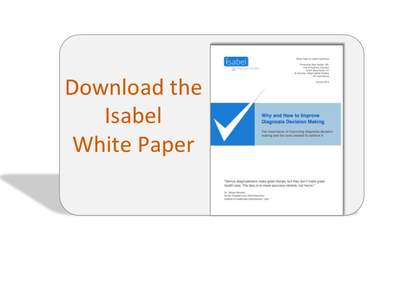- Privacy Policy
- Terms & Conditions
- Contact us
- ©Isabel Healthcare 2025
6 Tips for Successful Differential Diagnosis Tool Adoption
 Implementing any new system or protocol into a large and busy environment such as a hospital can be daunting, and it can often seem like there are more hurdles to overcome than the venture is worth. But it doesn’t have to be this way. With a few tips and some careful preparation, a smooth adoption of a differential diagnosis tool such as Isabel in your institution is perfectly achievable.
Implementing any new system or protocol into a large and busy environment such as a hospital can be daunting, and it can often seem like there are more hurdles to overcome than the venture is worth. But it doesn’t have to be this way. With a few tips and some careful preparation, a smooth adoption of a differential diagnosis tool such as Isabel in your institution is perfectly achievable.
1. Why do you need a Differential Diagnosis Tool?
To have success with any new hospital-wide diagnosis system or technology, everyone needs to be on the same page. Why do you want Isabel? Decide a clear end goal and a purpose for adopting tools like Isabel in the first place. “We want to reduce the number of inappropriate referrals,” or “We want to provide our clinicians with assistance when they encounter a case with diagnostic dilemma” for example. Make sure the leaders of your organization are entirely supportive of the adoption, and everything will go a whole lot smoother from the offset.
2. Who cares?
Once you have leadership onboard with a clear vision for improvement, it’s time to rally up your stakeholders. Key stakeholder departments such as risk management, medical education, nursing and marketing could all see a benefit from adopting a diagnosis tool such as Isabel, so get them interested and excited about all the improvement this could make to their business, and the rest of the troops are more likely to follow.
3. Find a Champion
So you have a clear end-game which is fully understood by leadership, and an army of stakeholders eager to learn more about the new tool. What you need now is a spokesperson, a leader to build morale and encourage support: you need a Diagnosis Tool Champion. Pick someone who is in the middle of the action, like a practicing clinician, who can instill their own enthusiasm for improving diagnosis and quality of care in everyone.
4. Follow a plan
There is nothing better than a plan coming together, so ensure you’re prepared for the day your organization will actually adopt your diagnosis tool. If everyone knows when the implementation is taking place, no one can be left in the dark. Spreading the word before adoption is key for success in the crucial first few weeks. You could even arrange a launch event, where awareness is promoted, and senior clinicians, along with your ‘champions,’ attend to show their commitment.
5. Make it easy:
Here’s the scenario: you have to click through 8 unnecessary pages to get to the one system needed for the patient, and even then you may not be in the right place, all the while wasting valuable patient-doctor time: sound familiar? There is no point in rolling out a new tool if isn’t going to add value and be easy to access and use. There’s a few quick things you can do here that will make a lot of difference:
-
Create shortcuts on desktops
-
Add favorite tabs in browsers
-
Include access in documentation screens
-
Integrate data into the tools, to cut down on keystrokes
-
Quick access icons on tablets
This way, anyone coming to the EMR knows exactly where to source the tool, and everyone is getting the most out of it.
6. Keep it Top of Mind:
Once the system is operational, regular campaigns to promote the continual use of the tool will help keep it in everyone’s minds. The tool could even be mandated into some scenarios, like re-admissions to ED within 48 hours, or be used to enhance referrals. This not only reminds people it’s there, but also shows them how useful it can be. Your ‘champions’ can regularly ask the residents and other users how they are finding it, requesting points for improvement and positive feedback. Act on the negatives quickly, and promote the successes, and you’ll find a lot more people open to using the tool.
Follow these 6 tips for successful Differential Diagnosis Tool Adoption, and you’ll be well on your way towards a smooth transition into systems like Isabel.
Want to know more about Diagnosis Decision Making and Isabel? Download our whitepaper:
Blogpost image attribution:
 by Anoto AB
by Anoto AB

Jason Maude
Jason is the CEO and Co-founder of Isabel. Prior to co-founding Isabel, Jason spent 12 years working in finance and investment banking across Europe. His daughter, Isabel, fell seriously ill following a misdiagnosis in 1999 and this experience inspired Jason to abandon his city career and create Isabel Healthcare Ltd.
Subscribe Here!
Recent Posts
Isabel DDx Companion with ChatGPT Integration - to help you diagnose even faster
At Isabel Healthcare, we’ve always been driven by one goal: to make clinical reasoning faster,..Virtual Triage: Do more questions lead to better patient outcomes?
One of the common misconceptions related to virtual triage / symptom checker tools is that the more..List Of Categories
- Differential Diagnosis Decision Support
- Differential diagnosis
- Symptom Checker
- Symptoms
- Medical Error
- Patient Disease Information
- Disease
- Clinical Decision Support
- Diagnostic Decision Support
- Isabel 1 Minute Read
- Diagnosis Error
- Diagnosis Skills Cases
- Healthcare Informatics
- Clinical Reasoning
- Evidence-based Medicine
- Medical Education
- Patient Engagement
- Symptom Triage
- Nurse Practitioner Education
- Nursing Decision Support
- Partnership
- Public Health
- COVID-19
- EHR
- Patient Empowerment
- Patient Safety
- rare disease

Start your FREE Trial today
Try the Isabel Pro DDx generator for 30-days - no payment card details required.




